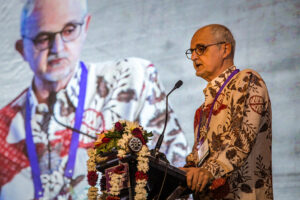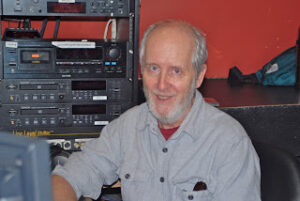Big storms – hurricanes, tropical cyclones, typhoons – will double in the next decades. Netherlands scientist Nadia Bloemendaal on stormy climate times. The Director General of CIFOR – the world’s largest forest science organization – Robert Nasi on forests and global landscapes in a changing climate. Earth does not care, so we must.
Listen to or download this Radio Ecoshock show in CD Quality (57 MB) or Lo-Fi (17 MB)
Heat from the future just struck Pakistan and India. Almost a billion humans on the planet went through days above 100 degrees Fahrenheit, 37 C. There is little air-conditioning. As Megan Darby writes in ClimateHomeNews: “Crops are withering. People too, but the extent of excess mortality will be modelled after the fact, not written on death certificates.” As 350.org’s Bill McKibben Tweeted: Ten percent of all the people on earth are sweltering under truly extreme heat tonight”.
Ten percent of all the people on earth are sweltering under truly extreme heat tonighthttps://t.co/u4uAhy4ulo pic.twitter.com/YRLKV7fQLf
— Bill McKibben (@billmckibben) April 28, 2022
On April 26, Dr. Elizabeth Sawin Tweeted:
"The heat also threatens wheat harvests at a time when global supplies of the crop are already under pressure due to Russia’s invasion of Ukraine. Heatwaves have hit India’s biggest wheat-producing states, Haryana, Uttar Pradesh and Punjab…https://t.co/hQbIsyRHjM
— Dr. Elizabeth Sawin (@bethsawin) April 26, 2022
Yes, it gets hot all through India and Pakistan. But not this hot in April. Temperatures went over 45 degrees Celsius (113 Fahrenheit) in many cities of India. And then it went further, close to 50 degrees C (122 F) in some places.
There was an unreported scorching April heat in South America too. Far away from global newsrooms of the West, other people are stressed, suffering, and dying because a few countries built empires burning fossil fuels. That is the ugly truth. A few play, the many pay. We must, must, must stop dumping greenhouse gases into the atmosphere.
people are stressed, suffering, and dying because a few countries built empires burning fossil fuels
Can forests help us? Can we save the birthing ground of species in tropical forests? We will talk with the Director General of CIFOR, the largest forest science organization in the world. Famed scientist Dr. Robert Nasi has a warning though: other life does not care if humans fail and go extinct. Earth is not a benign playground, all made for us, he says.
But first, yet another alert from science: in most parts of the world, the probability of tropical cyclones strikes double – not by 2100, but 2050 – during the next decades. In some places the risk of hurricanes, typhoons, or cyclones returning is four time greater, or even more. Get ready for a stormy world.
===========================================================================
NADIA BLOEMENDAAL
TWICE THE HURRICANES-TYPHOONS-TROPICAL CYCLONES
It seems the world is being hit with more big storms. But is that true? Call them hurricanes, typhoons or tropical cyclones, will they get worse in coming decades as the world warms?
The answer has been unknown, and unknowable with current records and tools – unless someone finds the patterns to how tropical cyclones work. That is the Thesis and new paper from Nadia Bloemendaal at Free University Amsterdam. Nadia has won several awards for her work on risks – even before completing her Doctorate, including one from the big insurer Lloyd’s.

When planning risk and climate policy, world governments depend on the latest global climate models. But those models leave us blind to developing cyclone risks. The model allocations of space and time are too large to pick up violent events over days. So Nadia and associates developed a new algorithm called STORM. It works when tested against long historic measurements of wind speeds. When applied to the future, the results are scary for billions of people.
Nadia led the new paper titled “A globally consistent local-scale assessment of future tropical cyclone risk“. The paper is open access, anyone can read it for free. If you live in big storm-prone zones, you might want to do that. As Nadia tells us, that storm zone is expanding toward the Poles. Plus the global economy everywhere can be hurt when key cities are damaged.
Listen to or download my 29 minute interview with Nadia Bloemendaal in CD Quality or Lo-Fi
This study finds:
“the probability of intense Tropical Cyclones, on average, more than doubles in all regions except for the Bay of Bengal and the Gulf of Mexico.”
The United Nations just released a report showing disasters, of all kinds, are increasing rapidly around the world. Call them typhoons, cyclones or hurricanes, but these big storms are among the worst killers with the biggest damage. This study suggests the world becomes a noticeably more dangerous place, even in the next few decades.
Oh by the way… “Australia faces the largest relative increase in exposed population to category 3 RPs below 500 years, amounting to 9375% (Table 2)”] (Bloemendaal et al, 2022) “RP” stands for “return-period” which translates into storm frequency (see more notes on that below).
WILL THERE BE MORE STORMS?
A couple of decades ago, scientist Kerry Immanuel suggested America would be hit by more hurricanes as the world warmed. Then came a surprise: the number of hurricanes did not increase, but the intensity of super storms did. We know storms will have more energy, but will we have more or them? According to Bloemendaal, there have been at least two previous attempts to model storms, and in particular, what scientists call “the return-period”.
The return factor boils down to the public perception of large, dangerous storms coming more often, as we advance through the next three decades. We could still have a weak storm season with only a few big ones. But measured over a decade or two, the statistics should show we had a lot more extreme storms in many places of the world, and in total.
The paper says, quote: “At the 1000-year R[eturn] P[eriod], the largest increase in maximum wind speed is found for San Diego (USA), increasing from 34.3 m[eters]/second] to 42.9 to 48.2 m/s. “ What does that mean for people in San Diego? I think climate scientists could help public understanding by interpreting the “return-period” further, so anyone understands it.
I also ask: will the biggest storms get even bigger, or is a there a limit approaching? In the interview, Nadia says there is an upper limit to storm size, determined by atmospheric systems. The continent-killing mega-storm is not coming, except maybe in the movies.
Nadia also led this 2020 paper: “Generation of a global synthetic tropical cyclone hazard dataset using STORM”. STORM, is a “newly developed synthetic resampling algorithm”. It can process vast pools of data, whether that is historical weather records or the output of climate models of the future. But this algorithm can detect and work with short-lived high intensity events like storms. The new 2022 paper on future tropical cyclone risk builds on this earlier work – building a data machine designed to process winds and in particular, cyclone data. Nadia and colleagues created the machine in 2020, and new results in 2021, which finally published 6 months later in March 2022. In fact, all this new work on tropical cyclones is Nadia’s PhD Thesis.
All datasets presented in this study are publicly available and can be used as (forward looking) hazard maps in catastrophe models commonly used by the public (e.g., academia, policymakers, and nongovernmental organizations) and the private sectors [e.g., consultancy and (re) insurance companies]
Note: the study results may be conservative regarding the number of people impacted by changing storms in climate disruption. The study assumes a constant population (instead of growth in most places in reality) and cannot account for future mass migration. Migration is already millions of people from Syria, Ukraine, Africa, and Central America. And the big climate shift that will drive more millions away from disaster zones, and places to hot or dry to live – has just begun. It seems likely people will continue to migrate toward coastal super-cities, many of them in the big storm zone.
==============================
ROBERT NASI – GLOBAL FOREST EXPERT
Isn’t it wonderful how Nature evolved to support us? Except that isn’t how it works at all. A life-time leader in conservation warns: “Planet Earth is not a delicately balanced, benign Being.”
Robert Nasi should know. Dr. Nasi is a French-trained ecologist, now Director General of the world’s largest forest science organization, CIFOR. We will find out what that is, and the changing role of tropical forests, here on a climate destabilized planet.

Dr. Robert Nasi, Director General CIFOR and ICRAF
We welcome Robert Nasi from the CIFOR headquarters in Bogor Indonesia.
Listen to or download my 27 minute interview with Robert Nasi in CD Quality or Lo-Fi
In the 1990’s, British scientist James Lovelock suggested planetary life grew into a kind of co-operative Being, which he called “Gaia”. After some criticism, Lovelock renounced his own theory. But if a belief in “Gaia” comforts some people in uncertain times, why question it? The problem is: science, and particularly the study of long past ages, does not lead to comforting Gaia. Life on this planet is fragile, and can be suicidal. See Dr. Peter Ward’s book “The Medea Hypothesis”.
You can listen to my interview with Peter Ward telling us, as Robert Nasi puts it, “Planet Earth is not a delicately balanced, benign Being.”
In his CIFRO blog post, Robert Nasi writes:
“Tipping points are rapid, brutal changes in Socio-Ecological Systems (SES) triggered by slow variables.”
Everybody needs to understand this key thought. I think the collapse of some natural systems, really bad stuff, may be like the fall of the Soviet Union. Everything seemed invincible in the USSR. But below the surface, a long decay suddenly erupted into a broken state. Are there parallels between social and historic tipping points, and our current fragile state here on Earth?
THE BIGGEST FOREST SCIENCE GROUP IN THE WORLD CIFOR
All that aside, we are privileged to have the Director General of CIFOR join us on Radio Ecoshock.
CIFOR stands for The Center for International Forestry Research . And that now includes another organization called World Agroforestry (ICRAF). With people in over 30 countries, CIFOR/ICRAF has a budget over 100 million dollars a year. Think of it like a smaller UN-type agency, but half the staff are scientists, most specializing in forests and forest life – but also in agriculture, and ways to generate human livelihoods in forests without destroying them.
Dr. Nasi and CIFOR-ICRAF are not “save the forests” organizations. They aim to use forests to attain human-specific goals, like feeding billions of people, or providing an alternative to fossil fuels – as well as to protect both climate and biodiversity. It is a tight-rope balance.
Robert Nasi talks about the need to move from fossil power to a bio-based economy. How do we envision an economy based on biology rather than oil, coal, and gas? Can we do it without killing off natural systems?
See this CIFOR video: Should forest biomass count as renewable energy? CIFOR responds. January 17, 2018.
LET’S TALK ABOUT INDONESIA
How would you compare the importance of the great forests of Indonesia and the Amazon? Have we worried so much about the Amazon that we fail to see forest loss in Indonesia?
Late 1997, early 1998 was one of the strongest El Nino years. Newly cleared peat bogs, formerly wet and protected as rainforests, were drained for plantations and caught fire. The deep peat released so much carbon dioxide that developing country Indonesia rose to be one of the three biggest greenhouse gas emitters on the planet. Smoke buried much of South East Asia. It was a major event in climate change. It happened again in 2017.
Now the two biggest pulp and paper companies, APP and April, are both planning massive production expansion. Will this lead to conversion of Indonesia’s remaining intact forests including in West Papua and Kalimantan? The company says it will not expand further into the great forests, including home to the last Orangutans and other rare species. Plus: what would be the carbon impacts of that removing those carbon-intensive forests and draining more peat? Robert says “the jury is still out” about what big production increases will mean.
In the interview we discuss the Global Landscapes Forum. Robert Nasi was instrumental in setting up this meeting space for a wide range of scientists, experts, and governments. Previously, forest scientists might not meet experts in agriculture or a wide-range of related topics. The Global Landscapes Forum feeds inter-relationships, and breaks down silos.
==============
That’s it for Radio Ecoshock this week. Don’t forget, if you disagree with something you heard, or want to add more tips and links, post a comment down below! I delay the post slightly to filter out bots, but have faith, your comment will appear.
We are getting a good flow of guests in now, but I always value tips from listeners. Send your ideas and feedback using the Contact form on this site, or send me an email.
If you can spare a few dollars a month, please support making and distributing this program – free to anyone around the world.
Your time is valuable, thank you for listening – and caring about this world.
